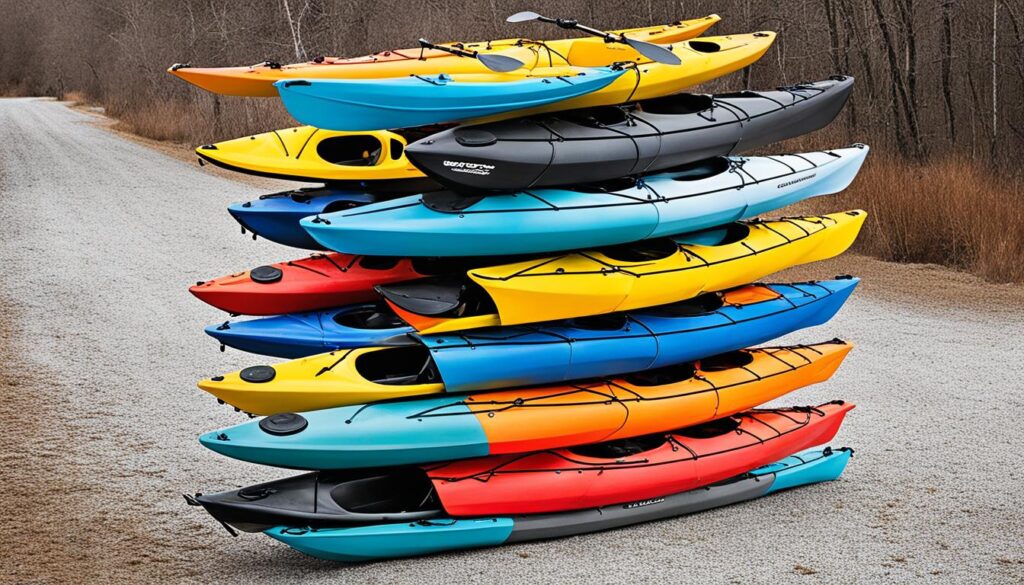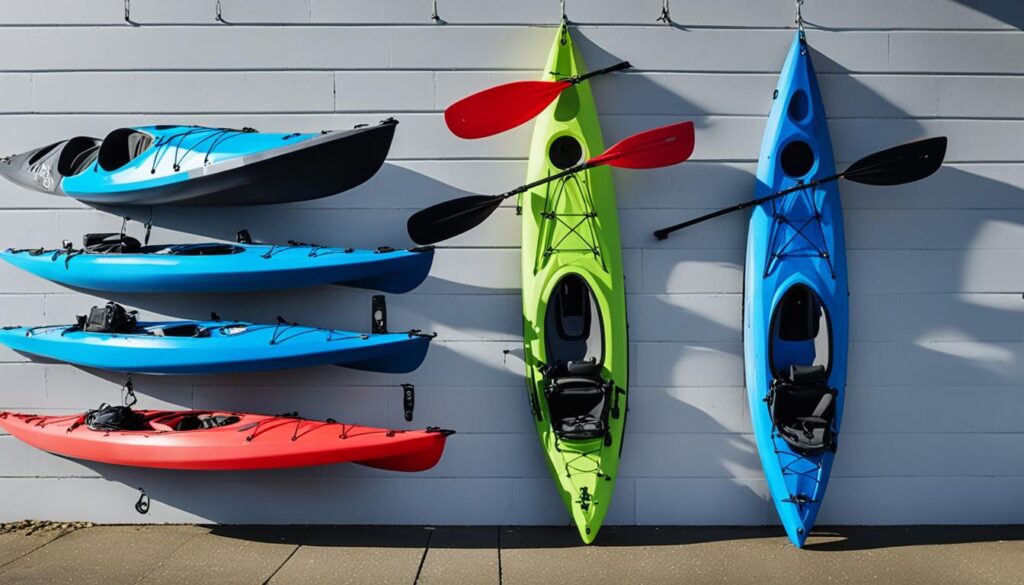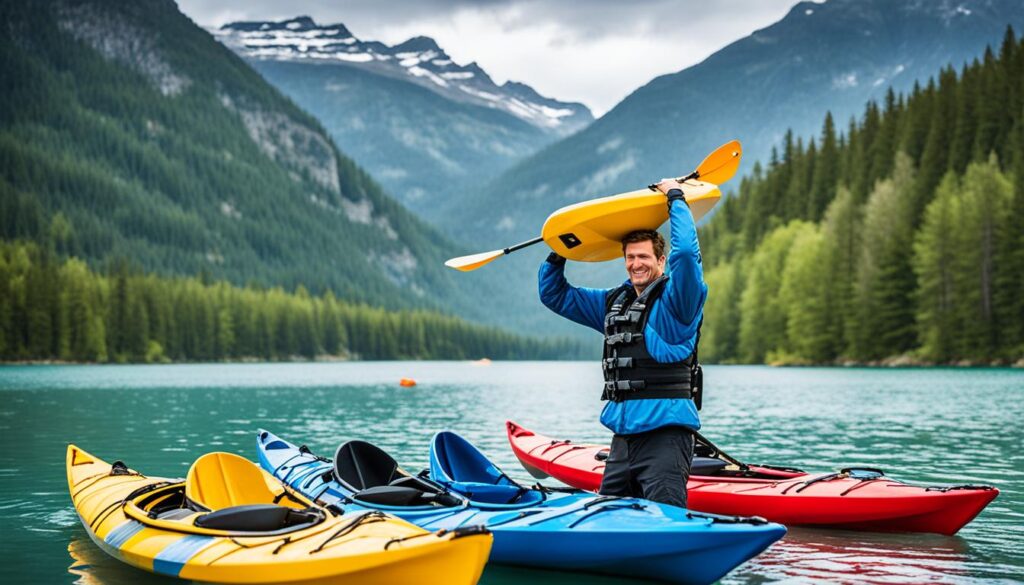Are you wondering if it is possible to stack kayaks on top of each other? The answer is yes, you can stack kayaks, but it’s important to do it correctly to ensure safety and prevent damage to your precious watercraft.
When it comes to kayak stacking, there are a few factors you need to consider. The weight and size of the kayaks, as well as their shape and material, play a crucial role in determining whether stacking them is feasible. Additionally, the proper techniques and safety guidelines should be followed to maintain the integrity of the stack.
Key Takeaways:
- Stacking kayaks on top of each other is possible, but it requires careful consideration of factors such as weight, size, shape, and material.
- Following safety guidelines is crucial to ensure the stability and integrity of the stacked kayaks.
- Proper storage solutions, such as wall-mounted or freestanding racks, can help maximize space and protect kayaks during storage.
- Aligning the kayaks, maintaining balance, and handling different types and sizes of kayaks are important tips to remember when stacking multiple kayaks.
- Regular inspections and proper securing techniques are necessary to ensure the safety and condition of the stacked kayaks.
Kayak Stacking Safety Guidelines
When it comes to stacking kayaks, safety should always be the top priority. Properly stacking kayaks ensures their stability and integrity, preventing any potential damage. Follow these guidelines to ensure a secure and hassle-free kayak stacking experience:
- Weight Distribution: Distribute the weight evenly when stacking kayaks. Place the heavier kayaks at the bottom and the lighter ones on top. This helps maintain balance and stability throughout the stack.
- Protective Padding: To prevent scratches and damage, use padding between kayaks. Foam or soft cushions can act as a protective barrier, reducing the risk of any accidental collisions or impact.
- Securing Mechanisms: Implement reliable securing mechanisms to hold the stacked kayaks together. Straps or bungee cords can be used to secure the kayaks tightly in place, minimizing any movement during transportation or storage.
By following these safety guidelines, you can stack your kayaks in the best way possible, ensuring their safety and longevity.

Proper Weight Distribution
When stacking kayaks, it’s important to distribute the weight evenly to maintain stability. Placing heavier kayaks at the bottom will provide a sturdy base, while lighter kayaks can be stacked on top without compromising the stack’s integrity.
Protective Padding to Avoid Damage
Using protective padding, such as foam or cushions, between kayaks will help prevent scratches and damage caused by friction during stacking or transportation. This extra layer of protection ensures that your kayaks remain in top condition.
Secure Stacking with Reliable Mechanisms
To keep your stacked kayaks secure, utilize straps or bungee cords to hold them tightly together. This will minimize any movement or shifting during transit or storage, preventing potential accidents or damage.
“Proper weight distribution and secure fastening are essential to maintain the safety and integrity of the stacked kayaks.” – Kayak enthusiast
Kayak Storage Solutions
In this section, we will explore various kayak storage solutions to help you keep your kayaks organized and protected. Proper storage is essential for maintaining the longevity and condition of your kayaks, and with the right solutions, you can maximize space and minimize clutter.
Wall-Mounted Racks
One popular option for kayak storage is wall-mounted racks. These racks are designed to be attached to the wall of a garage, shed, or other suitable space. Wall-mounted racks offer a space-saving solution and keep your kayaks off the floor, reducing the risk of damage. Additionally, they provide easy access and allow you to display your kayaks as unique pieces of art.
Freestanding Racks
If you have ample space in your storage area, freestanding racks are an excellent choice. These racks typically have multiple tiers or arms that can hold multiple kayaks securely. Freestanding racks are versatile and can accommodate different kayak sizes and types. They are also easy to assemble and can be moved around if needed.
Pulley Systems
For those with limited floor space, pulley systems can be a game-changer. These systems utilize ropes and pulleys to lift and suspend your kayaks from the ceiling. By utilizing the vertical space, pulley systems allow you to store your kayaks overhead, freeing up valuable floor space. It is important to choose a sturdy pulley system and follow proper installation instructions to ensure the safety of your kayaks.
Regardless of the storage solution you choose, there are a few key tips to keep in mind:
- Always clean and dry your kayaks before storing them to prevent mold and mildew buildup.
- Use foam padding or specialized kayak protectors to prevent any scratches or damage when placing the kayaks on racks.
- Securely fasten your kayaks to the storage system to prevent them from accidentally falling or shifting.
- Consider covering your kayaks with a tarp or kayak cover to provide additional protection from dust and debris.
By implementing these kayak storage solutions and tips, you can keep your kayaks organized, easily accessible, and in great condition for your next paddling adventure.

Tips for Stacking Multiple Kayaks
When it comes to stacking multiple kayaks, it’s important to follow proper techniques to ensure stability and prevent damage. Here are some practical tips to help you stack your kayaks effectively:
- Align the kayaks: Before stacking, make sure the kayaks are aligned with each other. This will help maintain balance and stability.
- Maintain balance: Place the heavier kayaks on the bottom to create a stable foundation. Distribute the weight evenly to prevent the stack from tipping over.
- Use padding: To avoid scratches and dents, place padding between the kayaks. Foam blocks or pool noodles work well for this purpose.
- Secure with straps: Use strong and reliable straps to secure the kayaks together. Tighten the straps properly to keep the stack intact.
- Consider kayak sizes: When stacking kayaks of different sizes, place the larger kayaks at the bottom for better stability.
Remember, safety should always be a priority when stacking kayaks. By following these tips, you can ensure a secure and well-organized stack of kayaks.
Expert Tip:
“When stacking kayaks, it’s essential to maintain balance and distribute the weight evenly. Take your time and be cautious during the stacking process to avoid any accidents or damage.” – Jane Miller, Kayaking Expert

| Kayak Stacking Tips | Description |
|---|---|
| Align the kayaks | Ensure the kayaks are properly aligned before stacking. |
| Maintain balance | Place the heavier kayaks at the bottom for a stable stack. |
| Use padding | Place foam blocks or pool noodles between kayaks for protection. |
| Secure with straps | Use strong straps to secure the kayaks together. |
| Consider kayak sizes | Place larger kayaks at the bottom for better stability. |
Ensuring Kayak Stacking Safety
When it comes to stacking kayaks, safety should always be a top priority. Proper lifting techniques, securing the stacked kayaks, and regular inspections are essential to ensure the stability and condition of the stack. By following these guidelines, you can stack kayaks safely and protect them from unnecessary damage.
Proper Lifting Techniques
Before you begin stacking kayaks, it’s important to use the correct lifting techniques to prevent injuries. Remember to:
- Use your legs, not your back, to lift the kayaks.
- Keep your back straight and lift with your leg muscles.
- Ask for assistance if the kayaks are too heavy to lift alone.
By using proper lifting techniques, you can minimize the risk of strain or back injuries.
Securing the Stacked Kayaks
To ensure the stability of the stacked kayaks, it’s crucial to secure them properly. Consider the following guidelines:
- Use padding or foam blocks between each kayak to prevent scratches and damage.
- Utilize kayak straps or bungee cords to secure the stack tightly.
- Regularly check the straps for any signs of wear or loosening.
By securing the stacked kayaks tightly, you can prevent accidents and keep the kayaks in place during transportation or storage.
Regular Inspections
Regularly inspecting the stacked kayaks is essential to ensure their safety and condition. Regular inspections allow you to identify any potential issues and take necessary actions promptly. Here are some key points to consider:
- Check the integrity of the straps or bungee cords regularly.
- Look for any signs of damage or wear on the kayaks.
- Verify that the kayaks are still properly aligned and balanced.
By conducting routine inspections, you can catch any problems early on and prevent accidents or further damage.
Remember, safety should always be a priority when it comes to kayak stacking. By following proper lifting techniques, securing the stacked kayaks, and conducting regular inspections, you can ensure the safety of both the kayaks and the individuals handling them.

| Common mistakes to avoid: | Best practices for kayak stacking: |
|---|---|
| Stacking kayaks unevenly, causing instability. | Ensure the weight is evenly distributed between the kayaks. |
| Using insufficient padding, leading to scratches and damage. | Use foam blocks or padding between each kayak to protect them. |
| Securing the stack loosely, risking the kayaks moving or falling. | Use kayak straps or bungee cords to secure the stack tightly. |
| Ignoring routine inspections, allowing issues to go unnoticed. | Regularly inspect the stacked kayaks for any signs of damage or wear. |
Conclusion
After exploring the topic of stacking kayaks, it is clear that following safety guidelines and proper storage techniques is crucial. By doing so, individuals can stack kayaks securely and ensure their longevity.
Throughout this article, we have discussed the importance of weight distribution, protective padding, and securing mechanisms when stacking kayaks. Properly aligning the kayaks, maintaining balance, and avoiding potential damage are also key considerations. It is essential to handle different types and sizes of kayaks with care during the stacking process.
To maximize space and protect kayaks during storage, we have explored various kayak storage solutions, including wall-mounted racks, freestanding racks, and pulley systems. These options provide efficient and convenient storage, allowing kayaks to be safely stored when not in use.
Remember, regular inspections are necessary to ensure the stability and condition of the kayak stack. By implementing these safety guidelines and storage techniques, individuals can enjoy the benefits of stacked kayaks while minimizing the risk of accidents or damage to their valuable equipment.
FAQ
Can you stack kayaks on top of each other?
Yes, you can stack kayaks on top of each other. However, it is important to follow proper safety guidelines and techniques to ensure stability and prevent damage.
What are some kayak stacking safety guidelines?
When stacking kayaks, it is crucial to distribute the weight evenly, use protective padding or foam between the kayaks, and secure them with straps or ropes to prevent shifting or falling.
What are some kayak storage solutions?
There are several kayak storage solutions available, including wall-mounted racks, freestanding racks, and pulley systems. These options help organize and protect kayaks while maximizing storage space.
What are some tips for stacking multiple kayaks?
To stack multiple kayaks, it is important to align them properly, ensure balanced weight distribution, and avoid putting excessive pressure or stress on any particular kayak. These tips help maintain stability and minimize the risk of damage.
How can I ensure kayak stacking safety?
To ensure kayak stacking safety, it is recommended to follow proper lifting techniques, regularly inspect the stacked kayaks for any signs of instability or damage, and secure the entire stack to prevent accidents or injuries.

